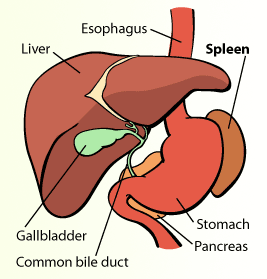Splenectomy (Pediatric)
 A splenectomy is an operation to remove the spleen. The spleen plays a role in immunity against bacterial infections. The spleen is in the uppermost area of the left side of the abdomen, just under the diaphragm.
A splenectomy is an operation to remove the spleen. The spleen plays a role in immunity against bacterial infections. The spleen is in the uppermost area of the left side of the abdomen, just under the diaphragm.
Splenectomy is rarely an emergency and can be scheduled electively at a time that is the most convenient for your family. There are specific requirements regarding immunizations and blood work that may need to be completed prior to this operation. Please check with your child's Hematologist prior to surgery.
Why is splenectomy necessary?
A variety of chronic illnesses, such as Hereditary Spherocytosis or Idiopathic Thrombocytopenic Purpura (ITP), may make it necessary to remove your child's spleen. While rare, trauma to the spleen with uncontrolled bleeding can create a situation where emergency spleen removal is necessary.
Why does my child need to be immunized before the operation?
Immunizations are given prior to splenectomy to prevent specific types of infections most common to patients post splenectomy. When immunizations are given prior to removing the spleen; they are more effective in protecting against infection.
How is a splenectomy performed?
A large incision may not be required. In most cases, a splenectomy can be performed laparoscopically by a Pediatric Surgeon using a small telescope and miniaturized instruments placed through band-aid sized incisions on the abdomen. The operation is completed in approximately two to three hours. During hospitalization, your child will receive intravenous fluids, antibiotics and pain medication. As soon as your child feels well enough he/she will be allowed to eat and drink and take pain medication by mouth (usually 2-3 days after surgery).
How long will my child remain in the hospital after the operation?
Your child must be able to eat, drink and be comfortable on pain medication taken by mouth before going home. Most children are ready to go home in two to three days after the operation.
Homecare After Surgery
Your child must be able to eat, drink and be comfortable on pain medication taken by mouth before going home. Most children are ready to go home in two to three days after the operation.
Pain Management
Prescription pain medication is not routinely required after hospital discharge. Most children only need Acetaminophen (Tylenol®) or Ibuprophen (Motrin®) once they are at home. Follow the dosage directions on the label. If your child is still uncomfortable, call our office and we may prescribe something stronger.
Care for Dressings
Gauze and clear plastic dressings, placed over the incisions, may be removed two days after surgery. Over the incision, there will be pieces of tape called Steri-strips®. On the Steri-strips®, there may be a small amount of blood. This is normal. Your child can bathe with the Steri-strips® in place. These can be removed one week after the operation. The skin surrounding the incision may be red and bruised, and the incision may be slightly swollen. This can last several weeks. There will be no visible stitches to remove because they are under the skin. The stitches will dissolve after several weeks.
In most operations, the wound is closed with dissolvable suture(stitches). These stitches are under the skin and do not have to be removed. In some children these stitches may come through the incision about 4 weeks postoperatively. This may be associated with a little local redness and pus and it may involve an end of the incision or a larger portion. This is normal and is best treated by gently cleansing the area with soap and water and waiting. When the suture falls out or completely dissolves, the wound will heal. If your child has worsening redness, swelling pain of the incision and a fever within 2weeks of the operation, please call our office.
Healing Ridge
After the incisions are healed you will be able to feel a firm ridge just underneath. This is called a healing ridge and it is normal to find this after surgery. The healing ridge usually lasts for several months before it softens and disappears.
Bathing Restrictions
Your child may bathe or shower as soon as two days after surgery. Once your child is feeling better, before discharge or at home, he or she may bathe or shower without restriction.
Activity Restrictions
There are no specific activity restrictions following surgery. Your child can return to school as soon as he or she feels well enough. If you need a letter sent to your child's school regarding the operation and recovery, please contact our office.
Antibiotics
Your child may require daily antibiotics post splenectomy; however, your child is still at risk for infection. If he/ she develops a temperature of 101°F (38°C), at any time after the operation, Penicillin (Erythromycin if your child is allergic to Penicillin) may be required to prevent an overwhelming infection. Contact your child's primary provider or Hematologist. If you cannot reach your child's physician, proceed to the emergency room nearest your home.
Do I see the surgeon again after the operation?
If all is going well, a visit to our office is not required. Our pediatric nurse practitioner will call you to check on your child's recovery. A visit with your child's Hematologist one to two weeks after the discharge is recommended.
When do I call the surgeon's office?
Call our office at 415-476-2538 for the following:
- Any concerns you have about your child's recovery
- A temperature of 101°F or higher
- A red incision
- Increasing pain and tenderness at the incision
- Any liquid coming out of the incision
